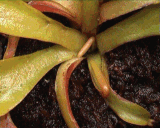 Image via Wikipedia1. Watering
Image via Wikipedia1. WateringOverwatering kills most houseplants. Looks can be deceptive, so to see if your soil is dry enough to water, try the finger test. Insert your index finger up to the first joint into the soil. If the soil is damp, don't water it.
2. Feeding
Foliage plants usually have high nitrogen needs, while doe flowering plants, K2O is needed. Slow release fertilizers can be mixed with the compost. However, certain plants like cacti and orchids need special fertilizer. Feed plants during their most active growth period.
3. Lighting
Plants like Sanseveria and Aspidistra require no sun. They can be placed away from a window. Spider plants need semi-shade. You can put plants like these near a window that does or does not get sunlight. Check the label to see what your plant needs.
4. Temperature
Most houseplants can survive in cool or warm temperatures, but drastic fluctuations of temperature may not be good for them. One thing that most plants cannot survive is gas heating. And if you have a plant that likes warm conditions, don't put it near an air conditioner in the summer.
5. Humidity
Some houseplants require a humid environment. One tip to maximize humidity is to put the pot inside a larger pot and fill in the gaps with stones or compost to keep in the moisture. Grouping plants together often creates a microclimate that they will benefit from. If you want, you can spray them with water once or twice a day depending on the temperature.
6. Re-potting
Some plants require re-potting for optimum growth but there are others that resent having their roots disturbed. Or their roots system may be small enough that they don't require re-potting. One way to check if your plant needs re-potting is to turn it upside down. Tap the pot to release the plant and check its roots. If roots are all you see, then re-pot. Sometimes the roots will come out of the pot. In this case, you should either cut them off or re-pot the plant.
You just need to give your plants a bit of care, and in turn, you'll reap the benefits. Indoor plants not only add to the beauty of your décor, but also give much pleasure to the indoor gardener - particularly those trapped inside for the winter!
Indoor Gardening & Houseplants: Recommended Resources:



















